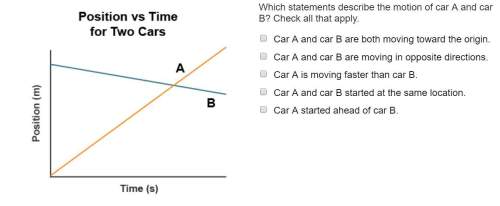
Physics, 02.10.2021 14:00 cupcake3103670
All surfaces in the illustration below are frictionless. Mass of the ball is 350 g.
Answer questions 5.41-5.4.4 in relation to the illustration below:
(use g = 9.8 m/s)
1 - 100
he -15
Determine KE at D.

Answers: 2


Other questions on the subject: Physics

Physics, 21.06.2019 23:30, reeseebaby89
You and a friend (alex) are at a a tree-top adventure park .. . part of the course requires you to climb up a rope. you both climb the same rope in the same amount of time. however, the tension in the rope is greater when alex climbs. who did the most work? alex did - more tension means more force - more force means more work was done you did - less tension means less force - less force means more work was done to find the work done, the force exerted and distance moved are multiplied. a couch is moved twice before you are happy with its placement. the same force was used to move the couch both times. if more work is done the first time it is moved, what do you know about the distance it was moved? when more work was done, the couch was moved less. when more work was done, the couch was moved further. when more work was done, the couch wasn't moved at all. when more work was done, the couch was moved the same distance.
Answers: 2

Physics, 22.06.2019 07:30, carlinryan
Which of the following is an example of motion in two dimensions?
Answers: 3

Physics, 22.06.2019 16:30, amayareyes101
Large electric fields in cell membranes cause ions to move through the cell wall. the field strength in a typical membrane is 1.0 x 10 7 n/c. what is the magnitude of the force on a calcium ion with charge +e? what is its acceleration? is it possible for a particle with the same charge as as calcium to have a different acceleration if placed at this location? what would change the acceleration: mass of the particle? diameter of the particle?
Answers: 2

Physics, 22.06.2019 20:50, dorkygirl
An ideal otto cycle has a compression ratio of 8. at the beginning of the compression process, air is at 95 kpa and 27°c, and 750 kj/kg of heat is transferred to air during the constant-volume heat-addition process. assuming constant specific heats at room temperature, determine (a) the pressure and temperature at the end of the heat-addition process, (b) the net work output, (c) the thermal efficiency, and (d) the mean effective pressure for the cycle. (4390 kpa, 1730 k; 423 kj/kg; 56.4%; 534 kpa)
Answers: 1
You know the right answer?
All surfaces in the illustration below are frictionless. Mass of the ball is 350 g.
Answer questio...
Questions in other subjects:

Mathematics, 30.04.2021 09:10

Mathematics, 30.04.2021 09:10




Spanish, 30.04.2021 09:10

Social Studies, 30.04.2021 09:10


English, 30.04.2021 09:10




